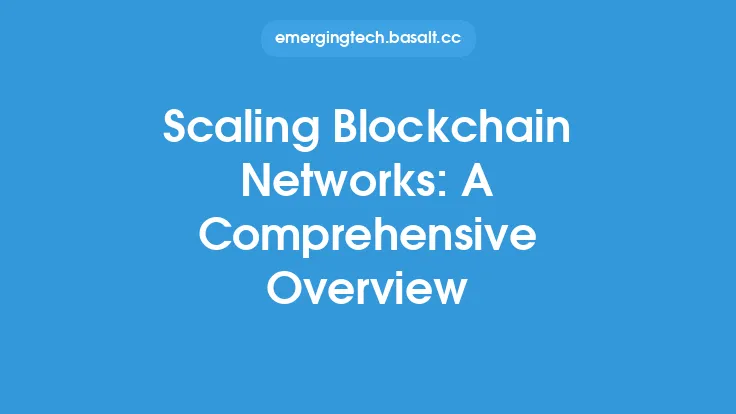The blockchain technology has been gaining popularity over the years due to its ability to provide a secure, transparent, and decentralized way of conducting transactions. However, as the number of users and transactions on the blockchain network increases, it faces scalability issues. One of the solutions to enhance blockchain performance and scalability is through the use of off-chain transactions. In this article, we will delve into the world of off-chain transactions, exploring what they are, how they work, and their benefits in enhancing blockchain performance.
Introduction to Off-Chain Transactions
Off-chain transactions refer to the transfer of assets or data that takes place outside of the main blockchain network. These transactions are not recorded on the blockchain, but they are still verifiable and secure. Off-chain transactions are made possible through the use of secondary layers or sidechains that are connected to the main blockchain. These secondary layers can process transactions at a much faster rate than the main blockchain, thereby reducing the load on the network and increasing its overall scalability.
How Off-Chain Transactions Work
Off-chain transactions work by using a combination of cryptographic techniques and smart contracts to facilitate the transfer of assets or data. The process typically involves the following steps:
- Locking: The assets or data to be transferred are locked on the main blockchain using a smart contract.
- Transfer: The assets or data are then transferred to a secondary layer or sidechain, where they can be processed at a faster rate.
- Verification: The transaction is verified on the secondary layer using cryptographic techniques, such as digital signatures and hash functions.
- Settlement: The transaction is then settled on the main blockchain, where it is recorded and made visible to all users on the network.
Benefits of Off-Chain Transactions
Off-chain transactions offer several benefits that can enhance blockchain performance and scalability. Some of the key benefits include:
- Increased scalability: Off-chain transactions can process a large number of transactions per second, making them ideal for applications that require high throughput.
- Improved security: Off-chain transactions use advanced cryptographic techniques to secure transactions, making them more resistant to hacking and other forms of cyber attacks.
- Reduced latency: Off-chain transactions can settle transactions in real-time, reducing the latency associated with traditional blockchain transactions.
- Lower fees: Off-chain transactions can reduce the fees associated with traditional blockchain transactions, making them more cost-effective for users.
Types of Off-Chain Transactions
There are several types of off-chain transactions, each with its own unique characteristics and use cases. Some of the most common types of off-chain transactions include:
- State channels: State channels are a type of off-chain transaction that allows users to transact with each other without having to settle each transaction on the blockchain.
- Payment channels: Payment channels are a type of off-chain transaction that allows users to make multiple payments to each other without having to settle each payment on the blockchain.
- Sidechains: Sidechains are a type of off-chain transaction that allows users to transfer assets between different blockchain networks.
Real-World Applications of Off-Chain Transactions
Off-chain transactions have a wide range of real-world applications, including:
- Cross-border payments: Off-chain transactions can be used to facilitate cross-border payments, reducing the latency and fees associated with traditional payment systems.
- Supply chain management: Off-chain transactions can be used to track the movement of goods and assets in supply chains, improving transparency and reducing the risk of counterfeiting.
- Gaming: Off-chain transactions can be used to facilitate in-game transactions, such as the transfer of assets or currency between players.
Challenges and Limitations of Off-Chain Transactions
While off-chain transactions offer several benefits, they also have some challenges and limitations. Some of the key challenges and limitations include:
- Security risks: Off-chain transactions can be vulnerable to security risks, such as hacking and other forms of cyber attacks.
- Scalability limitations: Off-chain transactions can be limited by the scalability of the underlying blockchain network.
- Regulatory uncertainty: Off-chain transactions can be subject to regulatory uncertainty, making it difficult for businesses and individuals to navigate the regulatory landscape.
Future of Off-Chain Transactions
The future of off-chain transactions looks promising, with several developments and innovations on the horizon. Some of the key trends and developments include:
- Increased adoption: Off-chain transactions are expected to see increased adoption in the coming years, as more businesses and individuals become aware of their benefits.
- Improved security: Off-chain transactions are expected to become more secure, as new cryptographic techniques and security protocols are developed.
- Greater scalability: Off-chain transactions are expected to become more scalable, as new technologies and innovations are developed to improve the throughput and capacity of blockchain networks.
Conclusion
Off-chain transactions are a powerful tool for enhancing blockchain performance and scalability. By allowing transactions to take place outside of the main blockchain network, off-chain transactions can reduce latency, improve security, and increase throughput. While there are challenges and limitations to off-chain transactions, the benefits they offer make them an exciting and promising area of development in the blockchain space. As the technology continues to evolve and improve, we can expect to see increased adoption and innovation in the use of off-chain transactions.





